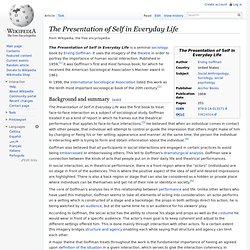

Proxemics. Proxemics is a subcategory of the study of nonverbal communication along with haptics (touch), kinesics (body movement), vocalics (paralanguage), and chronemics (structure of time).[1] Proxemics can be defined as "the interrelated observations and theories of man's use of space as a specialized elaboration of culture".[2] Edward T.

Hall, the cultural anthropologist who coined the term in 1963, emphasized the impact of proxemic behavior (the use of space) on interpersonal communication. Hall believed that the value in studying proxemics comes from its applicability in evaluating not only the way people interact with others in daily life, but also "the organization of space in [their] houses and buildings, and ultimately the layout of [their] towns.[3] Personal space[edit] The most portable types of space. A person's personal space is carried with them everywhere they go. Kinesthetic factors touching code visual code This category denotes the amount of eye contact between participants. T. Familiar Stranger (CHI 2004).pdf. People in places : the sociology of the familiar / edited by Arnold Birenbaum and Edward Sagarin.
Staging Mobilities - Ole B. Jensen - Google Книги. The Presentation of Self in Everyday Life. The Presentation of Self in Everyday Life is a seminal sociology book by Erving Goffman.

It uses the imagery of the theatre in order to portray the importance of human social interaction. Published in 1959,[1] it was Goffman’s first and most famous book, for which he received the American Sociological Association’s MacIver award in 1961. In 1998, the International Sociological Association listed this work as the tenth most important sociological book of the 20th century.[2] Background and summary[edit] The Presentation of Self in Everyday Life was the first book to treat face-to-face interaction as a subject of sociological study.
In social interaction, as in theatrical performance, there is a front region where the “actors” (individuals) are on stage in front of the audiences. The core of Goffman's analysis lies in this relationship between performance and life. See also[edit] Impression management References[edit] Notes Jump up ^ Macionis, John J. & Gerber, Linda M. Erving Goffman. Erving Goffman (11 June 1922 – 20 November 1982), a Canadian-born sociologist and writer, was considered "the most influential American sociologist of the twentieth century".[1] In 2007 he was listed by The Times Higher Education Guide as the sixth most-cited author in the humanities and social sciences, behind Anthony Giddens and ahead of Jürgen Habermas.[2] Life[edit] Goffman was born 11 June 1922, in Mannville, Alberta, Canada, to Max Goffman and Anne Goffman, née Averbach.[3][4] He was from a family of Ukrainian Jews who had emigrated to Canada at the turn of the century.[3] He had an older sibling, Frances Bay, who became an actress.[4][5] The family moved to Dauphin, Manitoba, where his father operated a successful tailoring business.[4][6] From 1937 Goffman attended St.

John's Technical High School in Winnipeg, where his family had moved that year. In 1952 Goffman married Angelica Choate; in 1953, their son Thomas was born. In 1981 Goffman married socio-linguist Gillian Sankoff. Civil inattention. Civil inattention is the process whereby strangers who are in close proximity demonstrate that they are aware of one another, without imposing on each other – a recognition of the claims of others to a public space, and a sign also of their own personal boundaries.[1] In practice[edit] Civil inattention was described by Erving Goffman as part of the "surface character of public order ... individuals exert respectful care in regard to the setting and treat others present with civil inattention"[2] in order to make anonymised life in cities possible.

Rather than either ignoring or staring at others, civil inattention involves the unobtrusive and peaceful scanning of others so as to allow for neutral interaction.[3] Through brief eye contact with an approaching stranger, we both acknowledge their presence and foreclose the possibility of more personal contact or of conversation.[4] Negative aspects[edit] Encountering Strangers in Public Places: Goffman and Civil Inattention. By Wayne Mellinger Instructor, Antioch University To live in the city is to live in the presence of strangers.

For those of us living in cities, passing strangers on busy streets is unremarkable. We rush to our next appointment, preoccupied with our own thoughts, navigating through the crowded sidewalks. On “auto pilot,” we don't even think about our many brief encounters with unknown others in public spaces. There is a norm of anonymity which governs behavior in public between strangers. The Dictionary of Critical Social Science defines “civil inattention” this way: A norm of mass market societies which requires one carefully avoid interaction with other's physically present. The norm is that strangers do not talk to one another. Of course, this norm is violated millions of times each day. There are places at which encounters between strangers are more permissible, typically locations that imply pertinent information about the person— such as local gyms and airport waiting areas.